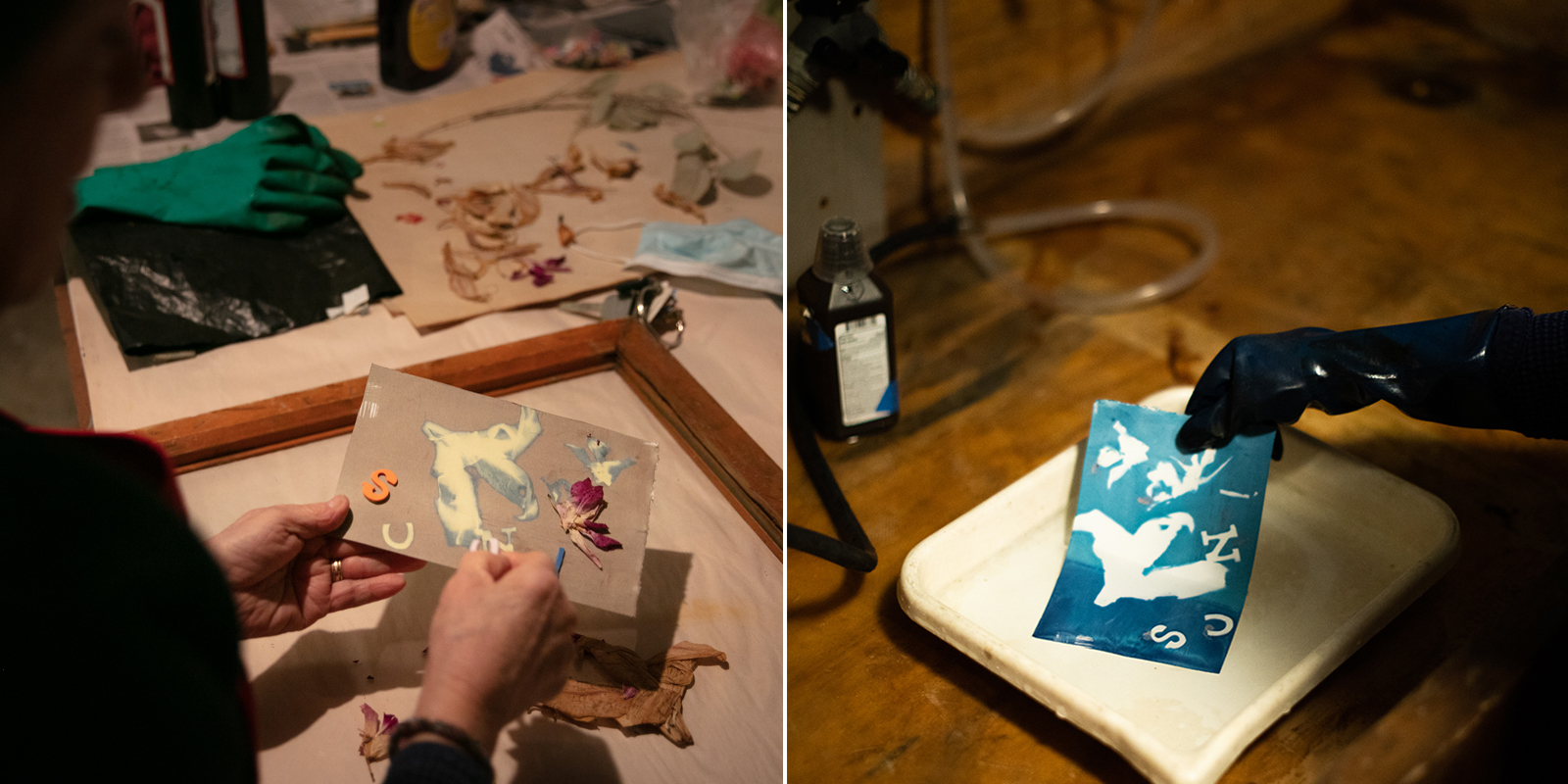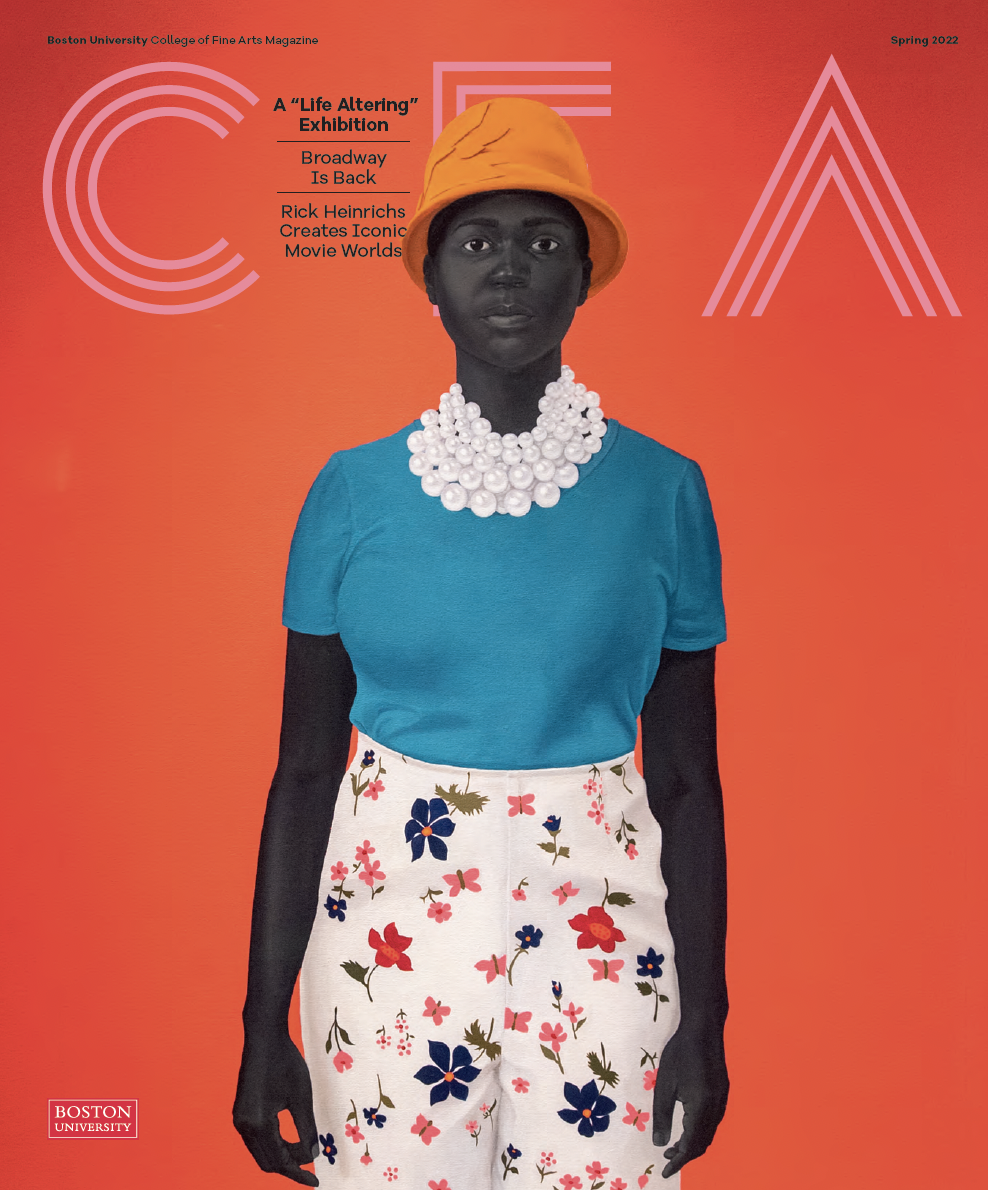Solar Art
Laura Blacklow blends traditional photo techniques with modern messages to create the books in her Quarantine Project
By Marc Chalufour | Photos by Conor Doherty

Blacklow prepares a solution she’ll use to coat her paper for a cyanotype.
Laura Blacklow learned photography long before the advent of digital cameras, but the Cambridge, Mass.–based artist never developed a fondness for working in a darkroom. Instead, she gravitated to processes like cyanotype and Van Dyke brown printing that she could do outdoors. “I just come alive when the sun comes out,” she says.
Those classic sun-printing methods are also conducive to experimentation. Blacklow (’67) has printed onto paper and textiles, and she’s created images with both photo negatives and three-dimensional objects. Developing the prints is often just the first step. She might color them with pastels or watercolor paints, sew them, or fold them into unique artist’s books.
Both artist and activist, Blacklow often blends words and images to convey a message in her work. She’s made prints with native rainforest plants to highlight the plunder of the Maya Biosphere Reserve in Guatemala and with plastic toy soldiers to expose violence against the Maya. For the past two years, Blacklow has drawn inspiration closer to home—pulling words from her readings, objects from her home, and flowers from her garden, she has created a series of accordion-fold books that she calls her Quarantine Project.
“The Best of Multiple Art Forms”

To make a sun print, she lays the coated paper and objects she plans to print on a tray, covers them with a sheet of glass, and carries it all outside.
As a kid growing up in Washington, D.C., Blacklow followed the work of Jacqueline Bouvier, a photographer and columnist for the Washington Post before Bouvier married John F. Kennedy (Hon.’55). CFA didn’t have a darkroom when she attended, so Blacklow studied painting and drawing, then trekked down Comm Ave to take a photojournalism course at the College of Communication. A Robert Rauschenberg exhibit at Boston’s Institute of Contemporary Art during her senior year made a lasting impression.
“This man was combining photography with painting. I know it wasn’t journalism in the strict sense, but he was making statements about being alive,” she says. “He just knocked me out.” Blacklow began melding mediums and hasn’t stopped. More than five decades later, she still considers Rauschenberg her biggest influence—although the form that she has devoted most of her career to isn’t framed prints meant to be hung on a wall. “I’m not a person who needs to make heroic, large artwork,” she says. “I like little, intimate messages.”
To Blacklow, a book represents the best of multiple art forms. Each page can be observed alone, like a photograph or painting, while the book itself occupies three dimensions, like a sculpture. And the physical act of studying and turning the pages takes time, like viewing a film. “There’s such an intimacy there. You can hold it in your lap. You can leaf through it frontward and backwards,” she says.
The Quarantine Project
The pandemic cut Blacklow off from her usual sources of inspiration: traveling and doing deep archival research. Quarantined at home, she tended to her flower garden where she grows hibiscus, lilies, astilbe, hosta, ferns, iris, daffodils, tulips, crocus, bleeding hearts, wisteria, and cohosh. She cleaned out her grown son’s old closet and discovered a box of his high school English books and began reading, for the first time, James Baldwin, Nadine Gordimer, and James McBride.

Sometimes, she’ll use an indoor artificial exposure unit to make her prints if there is not enough sun outside.
The words of others help Blacklow process world events. “I’ve been an avid journal keeper since I was a child,” she says. “I write down quotes, I write down dreams.” With the pandemic worsening and amid the national reckoning over the killings of George Floyd, Breonna Taylor, and Ahmaud Arbery, she decided to share some of the quotes she found most helpful. “It’s so hard to have hope sometimes. And I’m an optimist,” she says.
Blacklow began pairing quotes with plants from her garden or other objects found around her house, like old locks and keys, and making sun prints in her yard. Quarantine Project captures a vision of the pandemic that’s uniquely her own. Blacklow has produced more than a dozen one-of-a-kind books, drawing from sources as disparate as Native American proverbs, the late congressman and civil rights leader John Lewis (Hon.’18), 13th-century Persian poet Rumi, and contemporary Russian poet and mystery writer Elena Mikhalkova.
Each book is formed by a single sheet of folded paper that opens to reveal a print Blacklow created by laying objects and sheets of acetate, with words written on them, over light-sensitive paper.
Blacklow is quick to point out that she often employs more modern methods in her art. “I want to be really clear about this—I’m not a Luddite,” she says. When the first color Xerox machines were introduced, Blacklow printed onto the thickest paper its rollers could handle without jamming. She’s printed onto satin, which she had to stiffen with spray-on starch, experimented with Polaroid cameras, and embraced digital photography. “Spending a day in the darkroom with a red light is not my favorite thing,” says Blacklow, author of New Dimensions in Photo Processes: A Step-by-Step Manual for Alternative Techniques (Focal Press, 2018), now in its fifth printing. “What took me a day, I can do in 15 minutes with Photoshop and an inkjet printer.”

Inside her studio, she removes the objects and then rinses the paper in water to halt the cyanotype’s development process. “Cyanotype is my favorite because it’s the least fussy,” she says.
Photographers typically use paper that’s precoated with emulsion, but Blacklow likes to have more control over the surfaces she prints on. Her work begins in the renovated carriage house behind her home, where she has a studio and darkroom. If she’s making a cyanotype, she adds water to a mixture of potassium ferricyanide and ferric ammonium citrate to create an emulsion and, with the lights dimmed, brushes it onto sheets of paper—often a high-quality cotton rag stock. Then she hangs the sheets to dry or, if she’s in a hurry, uses a hair dryer. For Van Dyke brown, the emulsion is slightly different: water, ferric ammonium citrate, silver nitrate crystal, and tartaric acid.
“I Love the Accidents”
Blacklow’s process of making a sun print is as crude as the results are delicate. She lays a sheet of coated paper and the objects she plans to print on a tray, covers them with a sheet of glass, and carries it all outside. For large prints, she arranges everything outside, shielded from the light by a tent she made by stretching black mulching plastic over a wood frame. Then she whisks away the plastic tent and watches her images develop.
“I just come alive when the sun comes out.”
On her cyanotypes, the sharp contours of leaves, delicate petals, and skinny stems appear in shades of white against a deep blue background. Imagine a blueprint of a wildflower garden—cyanotype is the same process once used by architects to develop their plans. Van Dyke brown prints offer a more organic look, mixing golden yellows and browns.

When Blacklow makes a cyanotype, she may let it sit for an hour, an overexposure that creates a deep blue, as in Sonny’s Blues. The 12-panel accordion book features words from James Baldwin’s short story of the same name. Image courtesy of Blacklow
Blacklow doesn’t set a timer for her outdoor exposures, but watches them until she’s satisfied. The duration can vary greatly depending on the time of day, temperature, and cloud cover. A cyanotype may sit for an hour, a deliberate overexposure that creates a deep blue that Blacklow especially loves. She rinses the paper to halt the process: just water for a cyanotype, or a chemical fixer commonly used in photography for a Van Dyke brown. “Cyanotype is my favorite because it’s the least fussy,” she says.

Inherit the Earth, a Van Dyke brown print, uses a Native American proverb. Image courtesy of Blacklow
In Sonny’s Blues, a 12-panel accordion book, the paper is a deep blue-green, mottled with white that looks like clouds on an ominous day. Leaves seem to float in this fantastical sky. James Baldwin’s words, from a short story of the same name, flow across this scene: “The tale of how we suffer, and how we are DELIGHTED and how we may TRIUMPH is never new, it always must be HEARD…it’s the only light we’ve got in all this darkness.”
Inherit the Earth, a Van Dyke brown print, uses a Native American proverb: “We do not inherit the earth from our ancestors. We borrow it from our children.” A cluster of flowers—stems, petals, and all—reach across the page, parallel to the words. Each is rendered in shades of yellow and brown. They look burned onto the page, which, in a way, they are.
Part of Blacklow’s continued fascination with sun printing is that she never knows exactly what she’ll end up with. “I love the accidents,” she says. She doesn’t consider photography to be an exact representation of reality. “Just the fact that the three-dimensional world is translated onto a flat surface changes what you see.”
New Master’s in Fine Arts: Print Media and Photography
A form of art Laura Blacklow has spent her life on is now an MFA program. Beginning in fall 2022, CFA will launch an MFA in print media and photography. “This is a degree that bridges these two mediums,” says Lynne Allen, a professor of printmaking and director of the new program. “Printmaking and photography have much in common, including various techniques and the ability to make multiples. Bookmaking can also be a large part of a student’s oeuvre, and we encourage experimentation. I’m excited because this allows for a wider discussion about contemporary art—and print and photo’s place within it.”
Learn about CFA’s new program merging printmaking and photography practices.










